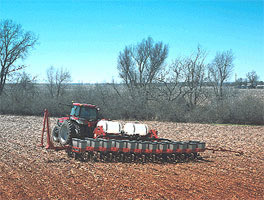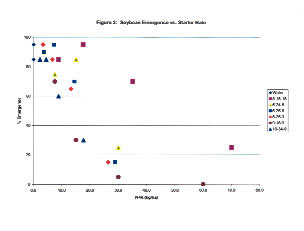
Starter Fertilizers For Corn—“Old Fashioned Goodness”
With all of the advances in crop production, it is easy to assume that new is always better. We don’t plant the same hybrids as we did ten years ago, or use the same herbicides, so there must be a better fertilizer program than our fathers used thirty years ago. The fact is, your father was right all along, for some very good agronomic reasons. With a few modifications to account for changes in tillage systems, your starter fertilizer program should look very similar to what your dad used.
 There are two main reasons that starter fertilizers work. The first is that phosphate, the main nutrient in most starters, reacts very quickly with soil minerals to form insoluble compounds. When the fertilizer is placed in a band, the concentration of the phosphorus is greater than the capacity of the soil to tie it up, so more remains available to the plants. The second reason is that crops in the grass family, like corn, have a high demand for phosphorus as seedlings. Dr. Murray Miller showed that the concentration of phosphorus had to reach 0.5% in five-leaf corn, or the yield potential of that plant was reduced. For a corn seedling with a small root system to meet this phosphorus requirement, there has to be a concentrated source of phosphorus close to the seed.
There are two main reasons that starter fertilizers work. The first is that phosphate, the main nutrient in most starters, reacts very quickly with soil minerals to form insoluble compounds. When the fertilizer is placed in a band, the concentration of the phosphorus is greater than the capacity of the soil to tie it up, so more remains available to the plants. The second reason is that crops in the grass family, like corn, have a high demand for phosphorus as seedlings. Dr. Murray Miller showed that the concentration of phosphorus had to reach 0.5% in five-leaf corn, or the yield potential of that plant was reduced. For a corn seedling with a small root system to meet this phosphorus requirement, there has to be a concentrated source of phosphorus close to the seed.
Starter fertilizer ratios
While phosphate is the dominant compound in most starters, there should also be some nitrogen. This is commonly included at a ratio of approximately one part nitrogen to four parts phosphate. This ratio increases the uptake of phosphate. Scientists have not been able to isolate the mechanism for this increased uptake, but speculate it may have something to do with maintaining the balance of electrical charges in the root, as positively charged ammonium ions are absorbed along with the negatively charged phosphate ions.
The exception to the 1:4 rule is in no-till corn. The rate of nitrogen mineralization is slower in most no-till soils, so the corn crop benefits from having an early supply of nitrogen. In this case, 30 to 40 kg/ha of nitrogen should be applied in the starter along with the required phosphate.
Early availability of potash is not as critical as it is for phosphate, unless the soil is quite deficient. Potash can be included in the starter as a convenient way to meet the K requirements of the crop. The ratio of K to the other nutrients will not affect its availability, but care should be taken to ensure that you don’t apply more potash than is safe for the seedling.
 Placement
Placement
Starter fertilizer placement is a compromise between early availability of the nutrients and crop safety. The closer the fertilizer is to the seed, the sooner the emerging roots can start using the nutrients. This is readily seen in the field where corn with seed-placed fertilizer is grown next to corn with the conventional 2x2 fertilizer band. At the 3-4 leaf stage, the seedlings with the seed-placed fertilizer will be larger, darker green and more vigorous. The other corn will soon catch up, however, as the roots reach the fertilizer band.
The downside to putting the fertilizer close to the seed is the risk of injury. You could liken starter fertilizers to sitting near a campfire. The warmth from a small campfire is welcome when you are sitting close to it, but if you add more fuel it will soon become uncomfortable unless you move further away. The maximum safe rates of fertilizer you can apply with the seed are much lower than application in a band away from the seed.
 The impact of too much nitrogen and potash close to the seed is clearly seen in Figure 1. In this greenhouse trial, with adequate moisture, the emergence of corn dropped sharply once the rate of N+K exceeded about 15 kg/ha. In dry conditions, as can occur in some springs, the safe rate is even lower. Figure 2 shows the impact of the same fertilizer rates on soybean emergence. Soybean emergence is reduced even by low rates of fertilizer with the seed, showing the greater sensitivity of this crop to fertilizer burn.
The impact of too much nitrogen and potash close to the seed is clearly seen in Figure 1. In this greenhouse trial, with adequate moisture, the emergence of corn dropped sharply once the rate of N+K exceeded about 15 kg/ha. In dry conditions, as can occur in some springs, the safe rate is even lower. Figure 2 shows the impact of the same fertilizer rates on soybean emergence. Soybean emergence is reduced even by low rates of fertilizer with the seed, showing the greater sensitivity of this crop to fertilizer burn.
The choice between seed-placed and 2x2 fertilizer placement will depend on your individual farming system. Seed-placed fertilizer has shown a yield response in soils where the 2x2 band does not increase yield because of high soil tests. In low-testing soils, however, the yield increase is greater from the higher rates of fertilizer in the 2x2 band. The low rate of seed-placed fertilizer is less than crop removal, so soil tests will tend to decline unless some other source of phosphorus, like manure, is being applied. The costs of the fertilizer materials, and the availability of application equipment, also have to be considered, so the ideal system will be different for each farm.